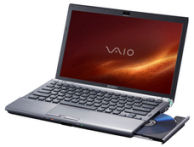What’s an “ultraportable” notebook? I don’t mean a tiny pseudo-PC, but a real computer. A system designed to be stripped down and easy to carry, but without too many compromises …
Stephen Manes wrote about looking for an ultraportable laptop with the right balance of features for his needs in the August issue of PC World — Laptops: In Search of Bearable Lightness.
 And now Sony has given its view of the right trade-offs for a small notebook with the introduction of its latest generation of Sony VAIO notebooks, available in August 2008.
And now Sony has given its view of the right trade-offs for a small notebook with the introduction of its latest generation of Sony VAIO notebooks, available in August 2008.
The comparison to the Apple MacBook Air shows very different ideas about where to compromise in cutting features.
The MacBook Air is positioned as full-sized (as in keyboard and 13” display), but incredibly thin (3/4 of an inch) and light (3.0 pounds). But the MacBook Air sacrifices an optical drive, hard drive capacity (only 80 GB), and most connectors (including video out and Ethernet).
In comparison, the existing Sony VAIO TZ (still in the product line) at about the same price point, shrinks the display (11.1”) and keyboard, but piles on more storage (to 320 GB) and a CD/DVD burner, and still comes in weighing less, at 2.7 lbs.
And the new Sony VAIO Z, also in the same price range, matches the MacBook Air display size (13.1”), and further increases the available processor (1.8 to 2.53 GHz), and memory (up to 4 GB), although coming in slightly heavier with the DVD burner (3.42 lbs.).
So we have general agreement on a 3 pound notebook starting under $2000, but with significantly different approaches to getting there — and while not compromising on at least one key feature.
Another alternative could have been to be more aggressive in reducing features to drop to around 2 pounds, both shrinking the display (as in the VAIO TZ) and omitting the optical drive (as in the MacBook Air), but still retaining sufficient performance to be a useful system. After all, you can always hook up to a larger display at your desk, and access storage though a flash drive and the network.
Sony actually took a shot at such a system with its Sony VAIO X505 notebook introduced in May 2004 as a limited experiment. It was thin like the MacBook Air, and smaller, with a 10.4” screen (so it fits comfortably in a regular 8 1/2 x 11 envelope). As a result, it weighed just 1.84 lbs. But the price started at a hefty $2999, and the power and storage were limited to a 1.10 GHz processor, with 512 MB RAM, and 20 GB disk.
However, the X505 did not catch on, and it seems that Sony still believes that users need an optical drive, even in this age of near-ubiquitous networking. Of course, Sony is heavily invested in supporting the Blu-ray format, so its new models support HD movie playback and burning 25 GB (or more) of data to a disc.
Even so, there’s a huge difference between carrying a 3+ pound notebook and system under 2 pounds — it’s like throwing a paperback book in your bag versus lugging around a big hardcover tome. So I am still interested in system that can slim down for the road, and yet with enough power to be my main working machine when docked on my desk.
See my full article, with specs on the new models: The 3-pound Ultraportable: Sony 2008 VAIO Notebooks.
![]() Find the Sony VAIO TZ and
Find the Sony VAIO TZ and
Apple MacBook Air on Amazon.com
